CLASS ANNOUNCEMENT #5 (Feb 1, 2018): The class is officially closed! Thanks to all who participated. Be sure to check page 43 for the closing "statement" and commendations.
CLASS ANNOUNCEMENT #4 (Jan 30, 2018): The timing worked out where this week's homework stretch is 10 days instead of the usual 7. So you've got extra time to complete the assignment! I'll look for submission through tomorrow, the 31st, and then I'll do a final post to close out the class.
BTW week 4's live event is archived if you missed it.
CLASS ANNOUNCEMENT #3 (Jan 15, 2018): Week 2 is done - We're halfway through the class! Today WEEK 3 begins where the focus is digital sculpting. This is a far more artistic method of shaping 3D models, so if you struggled in week 2, week 3 should be refreshing.
- Only 1 course to watch this week: Fundamentals of Digital Sculpting
- Live Event tomorrow at 2pm EST
- Please submit homework anytime between Jan 15 - Jan 21 with "BC1-1801 Week 3 Homework Submission" at the top of your post.
Keep up the awesome work, Class! So much creativity and hard work being contributed from everyone 🤘
CLASS ANNOUNCEMENT #2 (Jan 8, 2018): Week one is accomplished! Today WEEK 2 begins. We're moving forward from basic viewport interaction and into mesh modeling; into Edit Mode and the modifier stack.
- Reminder that you have 2 courses to watch this week: Mesh Modeling Fundamentals and Modeling with Modifiers.
- Live Event tomorrow at 2pm EST
- Please submit homework anytime between Jan 8 - Jan 14 with "BC1-1801 Week 2 Homework Submission" at the top of your post.
As always, don't hesitate to ask questions in this thread!
CLASS ANNOUNCEMENT #1 (Jan 2, 2018): The class has officially started! Today we held the first live event to kick things off. The recording will be published by tomorrow at the latest is now available in "Past Events".
That means it's now up to you to watch the Blender Basics Course and submit your homework to this thread. Please add a big, bold title to your homework submission reply so I can easily tell. Like this:
"BC1-1801 Week 1 Homework Submission"Also don't hesitate to ask questions along the way. I'll be checking this thread daily to answer questions, give advice, check homework.
This thread is for CG Cookie Citizens that are participating in the "Getting Started with 3D Modeling and Blender" class! Its purpose is to serve as central communication for all participating Citizens (excluding Hobby plan Citizens) to ask me and each other questions and to post homework. As the instructor of the class, I will be monitoring this thread on a daily basis (especially Mon-Thurs) throughout the month of January to review homework and answer questions.
This thread is intended only for Citizens who are participating in the class. Free members are welcome to observe the thread but please respect that communication is reserved for Citizens.

Welcome to the CGCookie Class: Getting Started with 3D Modeling & Blender! This is the first "Class" format where Citizen members are invited to focus together on a particular topic/skill together for a month. Participation is this:
It will take place from January 2nd through January 31st and the topic is for beginners that want to get into 3D modeling. The class is based on pre-recorded courses that students are expected to watch each week along with weekly Live Events.
Download the latest official version of Blender and watch the Blender Basics course. The goal this week is to simply get familiar with the application. We’ve all been there: Opening Blender (or any 3D package), gazing at all the crazy UI, trying to orbit in the viewport, crying...Ok, maybe you were stronger than me and didn’t cry. But the reality is 3D software is daunting. There’s SO MUCH to digest especially when you’re a beginner.
This first week we’re going to overview Blender and 3D from an absolutely beginner perspective. What is Blender for? What can it do? Wait, this isn’t a juicing seminar?
During the Live Event we're also going to open the floor, ask me anything (AMA) style, so I can answer all your questions about getting started with Blender.
HOMEWORK: Create a scene out of primitive shapes. It can be anything from a landscape to a spaceship to a character. Just get comfortable with creating and positioning mesh objects. Here's an example:
Take a screenshot of your scene and post it in a reply to this thread *during the week of Jan 1-6*.
Enter the world of mesh modeling! The oldest form of building objects in 3D, in the computer. We’ll discuss the technical art of “pushing and pulling verts” as modelers often call it. First, watch the Mesh Modeling Fundamentals and Modeling with Modifiers courses to be introduced to this wild, geometric world.
Practice makes perfect here and during this week's Live Event we’ll be mesh-modeling a few objects to demonstrate tools and workflow available with Blender. It’s ideal if you practice along with me!
HOMEWORK: Model either 1, 2, or 3 unique objects using mesh-modeling techniques. They can be as simple or as complex as you like, but they can't be primitives. I want to see that you've used mesh tools to significantly customize your shapes. For example, you could model a hammer, a cell phone, a keyboard, a game controller, a picture frame, a coffee cup - choose something fun!
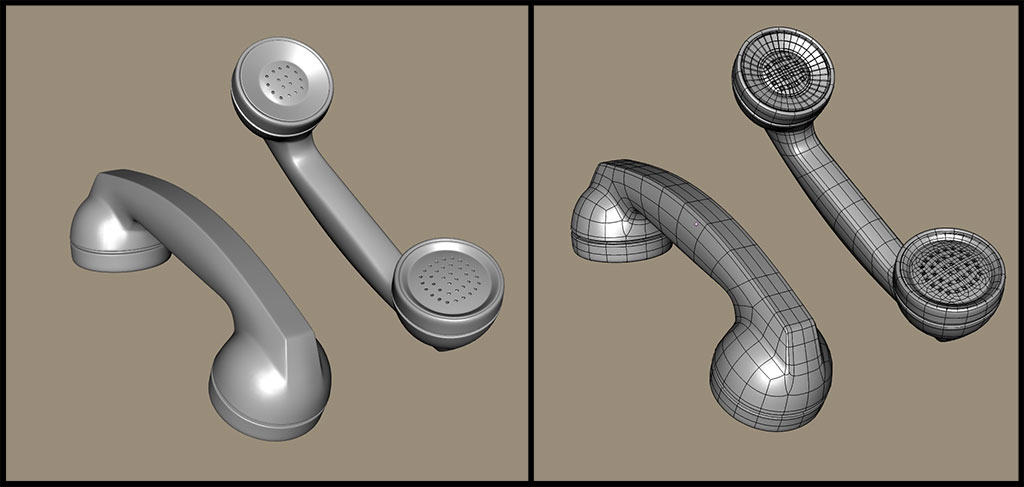
Take a screenshot of your shaded model + wireframe-over shaded (as pictured above) and post it in a reply to this thread *during the week of Jan 7-14*.
Digital sculpting is the more artistically intuitive method of 3D modeling. If pushing and pulling verts felt like the hard way of doing things, sculpting will be a welcomed alternative! Watch the Fundamentals of Digital Sculpting course this week.
During the Live Event, we'll discuss the pros and cons of digital sculpting as well as how it compares to mesh modeling. Again, practice makes perfect with any craft, and we will also practice sculpting. Be sure to have your pen and tablet ready!
HOMEWORK: *Submit during the week of Jan 15-21*
There’s still much more to learn about modeling with Blender. Remember, it’s a craft. Time + practice is the only way to develop your modeling skills.
This week your challenge is to dive into the Modeling in Blender Learning Flow. While the class gives you a boost, the Flow takes you further into intermediate and advanced modeling techniques/workflows. Test the waters and see how far you can go this week.
During the Live Event we'll discuss the journey of becoming a skilled modeler as well as the potential for turning it into a career. Finally, I’m going to sift through homework submissions to commend my favorites and offer critiques!
HOMEWORK: Model and/or sculpt something challenging this week! Try tackling a character or a complex vehicle, etc. Show me what you've learned; what you're capable of!
Take a screenshot of your shaded model and post it in a reply to this thread *during the week of Jan 21-31*.
The umbrella is a wonderful choice for modifier-based modeling - nice! You accomplished it quite well. As with the decorative wood paneling. You nailed it: A.
I'm very happy to hear that you're less shy around mesh modeling and modifiers. Based on your submission you seem to understand the concept and workflow clearly. And you're right about this thread - so many good submissions, critiques, and encouraging comments happening. I'm having a blast with this class :)
BC1-1801 Week 2
And the second model I made for this exercise:

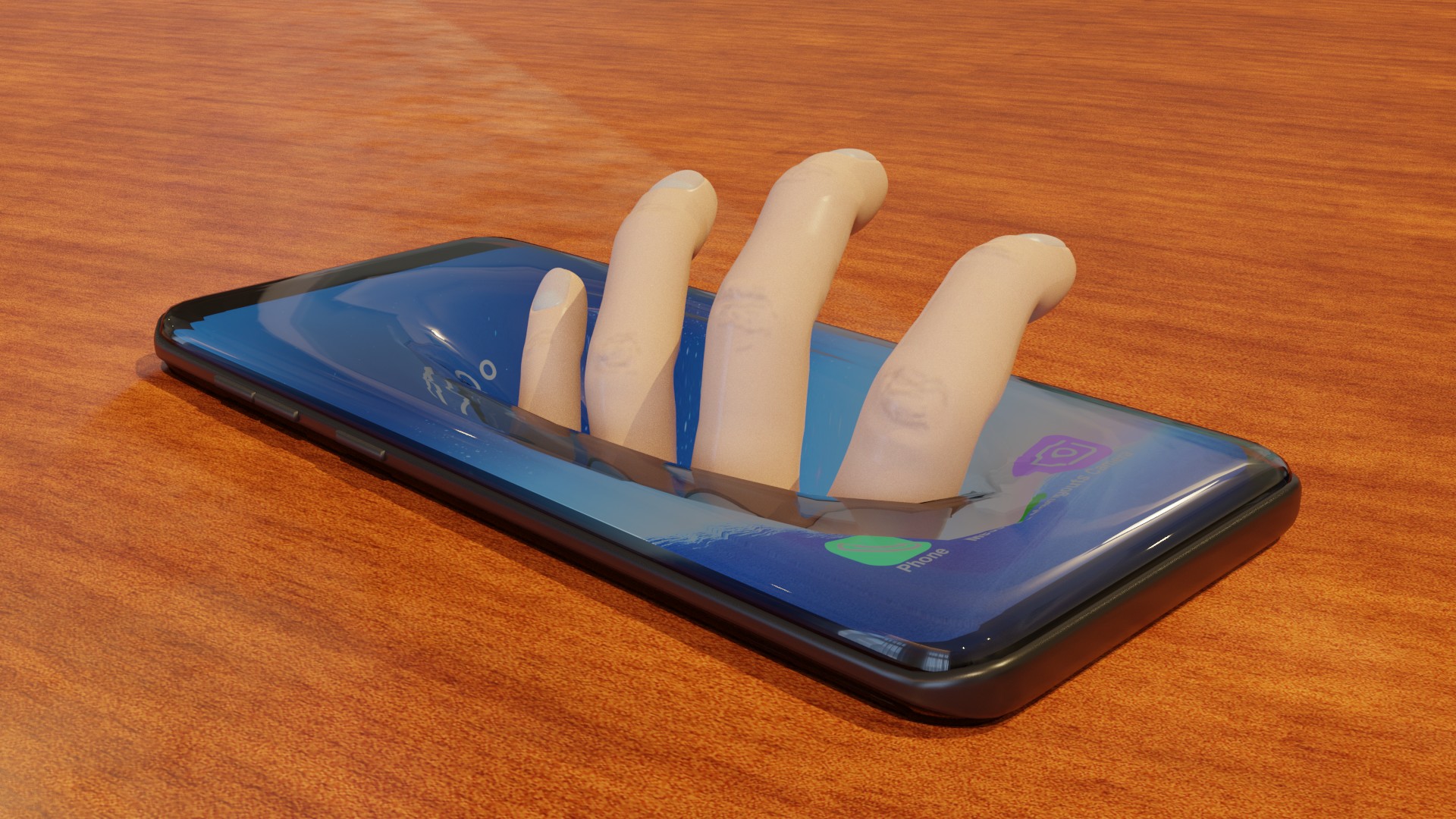
For full disclosure I modeled the fingers based upon Angela Guenette's Blenderella tutorial, so I didn't figure that part out myself. The phone took several tries, and I finally made it with multiple parts, rather than cut a Boolean out of main unit that holds the glass as that created a lot of non-quad geometry that doesn't play well with the subsurface modifier.
Beautiful work! I like the chair design, it reminds me of the chairs my mother used to have when I was a kid.
Ugh the flu claimed my wife this weekend. Sorry to hear you had the same this week, Scott. Thanks for powering through and submitting as well as still being so active in the thread 🙇🏻
The table looks great. Not much to say - just a thumbs up!
The chair looks like it gave you some trouble indeed. I hope this crit doesn't come across like kicking you when you're down, but the wireframe appears overly dense for what the shape is. Usually when the base mesh is that dense, it makes the modelers job much harder. Which is the impression I get from the images.
Bummer to hear you had so much trouble with the curve modifier. I'm not really sure how you were using the curve to accomplish the back spokes... 🤔 Maybe drop a link to your .blend and I'll take a look?
The candle and gem pouch look good though they too are on the high-poly-count side. Did you apply a subsurf?
PLEASE don't be discouraged with a B grade. You clearly know your way around the modeling tools. Though I feel there's some room for improvement - perhaps just a symptom of your less-than-ideal week - you still accomplished the assignment!
BC1-1801 Week 2 Homework Submission
Unfortunately I didn't have the time I would have like to put towards homework this week but I did watched the live stream again and follow along and complete the wheel and mug model. I also watch the recommended videos and completed the basic shapes assignment but struggled with the wheel when trying to add the rim and tread on my own. Which means I will have to spend more time in this area when I can. So here's the stream examples I completed. The basic shapes from the first recommend videos.

 Lastly, I don't know how this happened but when I started the wheel exercise and used the array modifier, for some reason my original object kept appearing at the bottom of the array making it a little tricky to work with. Example below.
Lastly, I don't know how this happened but when I started the wheel exercise and used the array modifier, for some reason my original object kept appearing at the bottom of the array making it a little tricky to work with. Example below.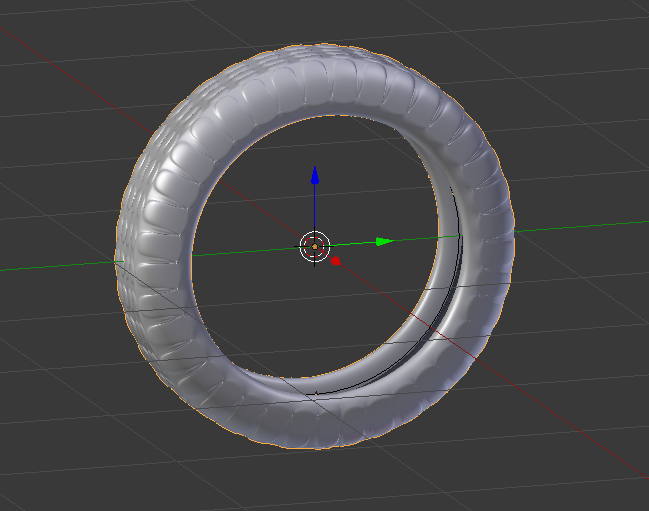
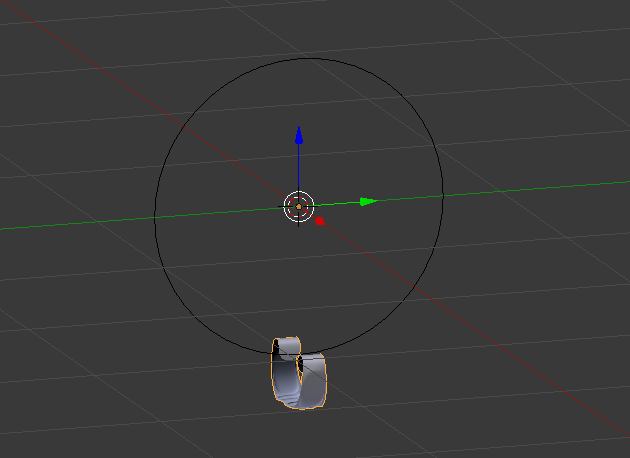
BC1-1801 Week 2 Homework Submission Pt 2

One of the things that I struggled with this week was deciding what to work on... That fit within the lessons of this week. Here, I went with a shield, something that I needed for one of my projects I'm working on anyway. This one wasn't too hard, and may go in and add a rim going around the shield, but this is at least the basics of it. For the rivets on the back, I didn't do a lot of modeling because they're going to be tiny and hidden, and rarely seen up close anyway, so they're just relatively basic shapes, but it was a detail that at least needed to be present. the straps and the shield design itself were essentially created from a cube using the techniques from this week.
BC1-1801 Week 2 Homework Submission Pt 3
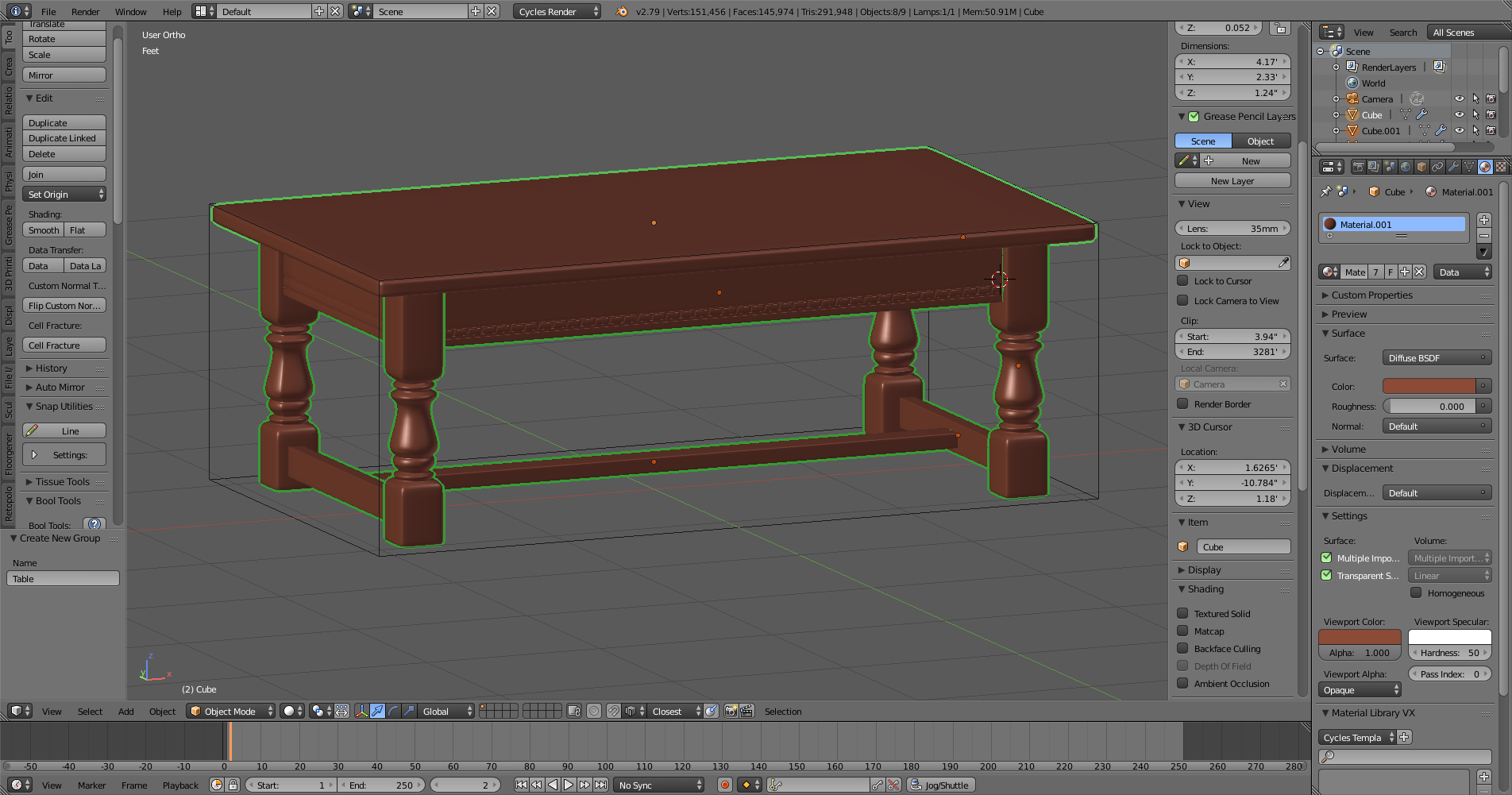
I put this table separate from the other because this one I felt I wanted to give a little more explanation on. I didn't want to do a basic table, so part of the challenge was finding something worthy of what I know I can do, but at the same time wasn't one I'd already modeled before.
One thing I often hear Kent talk about (and am surprised he hasn't said anything about this time around) is the importance of references. For this one, I searched a number of varieties of tables until I found one I liked. Then, I used one of my handiest 3D modeling tools -- a tape measure (which measures both imperial and metric). Since I didn't have the dimensions on the one I wanted to model, I took measurements from one I have (and have actually used as reference on a previous project) to get an idea of how big I should make it.
Here's where another great tip comes from, particularly if you're doing a room. Whenever possible, model to scale! In the Properties Panel on the Scene tab (The third one that looks like it has 3 objects on it, between the one that looks like two sheets of paper and the world one), you can set the units to Blender units, Metric Units, or Imperial. What's handy is if you have it set to either Metric or Imperial, you can enter in the measurement in ANY metric or imperial unit, and if it's not in the base unit you are using, it will convert it for you! I typically like to model in metric (for conversion reasons), but the important thing is that you have some kind of units set.
That's where the wireframe box comes in. That is what gave me the size for the table, so I knew how big to make it. For the rest, I took educated guesses on sizes, but I would have measured something similar. For example, The top part of the table looked like a reasonably similar thickness of my desk, so used a measurement of the thickness of my desk and figured the main pieces of the rest were based off of a 4in x 4in, a 1in x 2in, and a 1in x 4 in piece of wood, and made the lengths of them fit the spaces I needed filled.
The leg placements were easy with a mirror modifier in X and Y using the table top as the mirror object. Same with the side pieces and braces, but just on one of those two axis. To get the detail on the long panel, I used an array and a mirror. (And beveling and insets to get the details).
As for the leg shape, that was the most interesting to figure out (other than the detailing of the array), and probably the least easy to see what I did. For the legs, I started with a 12 vert, 2" radius cylinder. (I knew I was going to want 4 corners with 2 holding edges, so three at each corner x 4 corners = 12, and for a 4x4, 2xRadius = 4, so I needed a 2 in radius to get a 4" diameter). Next, I marked off a 4" section from the bottom (because it looked to be about the same length for that part as the width of the leg) and a 6" section from the top (because it looked a little longer). Then, I just added loop cuts and scaling at various points to get the shape of the middle part with an occasional bevel to make some of the edges have a bit more room to work with at that point (and a little scaling on the Z here and there).
Once the design on the middle, round part was set, it was just a matter of taking an edge from the top and bottom part and sliding them over to the corner piece to form a more square shape, but keep the round of the middle part. Only after doing all of that did I add in the holding edges for the square parts, but just on the tops and bottoms, not along the sides, since I'd already done that with the edge slide.
All of this was done in pieces, rather than a single object, because sometimes (such as in this case), it's easier to figure out just what you need to do to model something taking cues from the real world because it would be made in pieces, and it can be easier to figure out the shapes of those pieces individually and combine them into the whole.
And if you get nothing else from this, remember, Use references (both images and physical). Model to scale when possible. And play around. Sometimes it take a bit to come up with the solution that works.
And in typing that explanation, I remembered that I'd forgotten one mirror modifier, which, because of the angle, you wouldn't have known it was missing :D But that has been fixed now.
Kent, maybe you can help me...
Does Blender has some similar possibilities in package design like Cinema 4D?
https://youtu.be/-VRbBz3QlHE?t=1m58s
One last one...
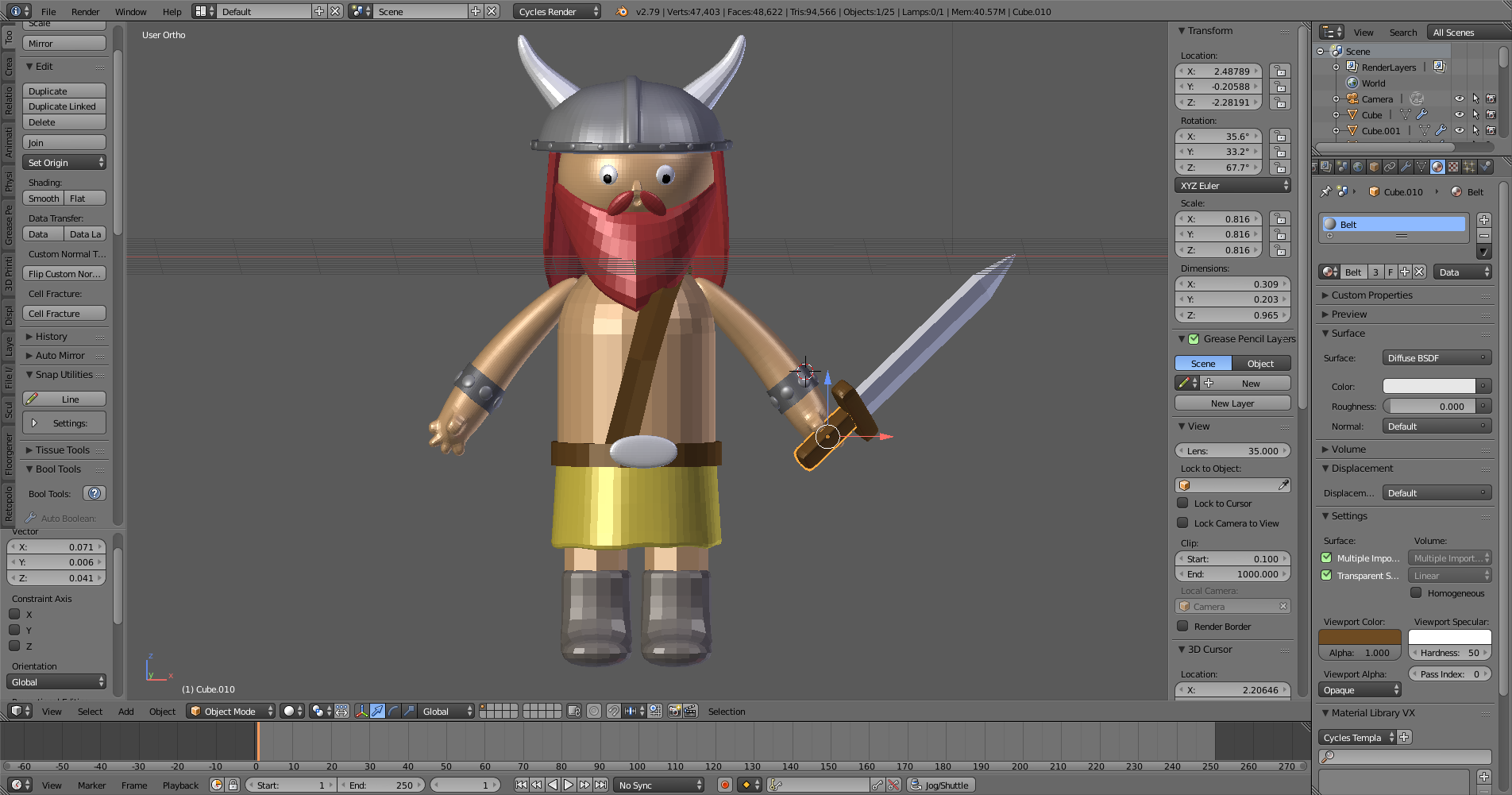
In some ways, this one might appear to be closer to last weeks, but there's a number of things I did on this one that actually took advantage of things from this week's lessons. For example, the loincloth, the band around the helmet, and the wristbands all use modifiers for their thickness. And there's a bit of using a subsurf modifier, applying it, and extruding pieces from the result.
This is actually one of the characters from the clay modeling book I had mentioned previously. As you can see, most of the shapes are very simple, though a few take a little tweaking.
Everything I did in creating this character is pretty much how I did a previs for a scene idea I wanted to test (though I used a few more primitives within the shapes on that particular one). I share this just to show that even characters are just taking what you've already learned and breaking them into small pieces.
Also, particularly for creatures, I think this can be just as effective way to create a basemesh... something that I believe is in this coming week's lessons... to use for sculpting, and can sometimes get you closer to the shape you want than using the skin modifier.
(This character is from the Modeling Clay: Fantasy Characters book, but done using "digital" clay.)
Looks like you've been accomplishing all sorts of exercises. lol. And all look very nice. The mug appears to have a 'lattice modifier' effect, no?
![]() alexsr Thanks for the submission. Trying to figure out what the object is..a small compost canister? Anyhoo, it's a good shape but you could accomplish this shape with significantly less geometry. With that in mind, it easily accomplishes the assignment with a B 👌
alexsr Thanks for the submission. Trying to figure out what the object is..a small compost canister? Anyhoo, it's a good shape but you could accomplish this shape with significantly less geometry. With that in mind, it easily accomplishes the assignment with a B 👌
As for the split along the seam, adding a holding edge to the bottom would be a solution, like this:
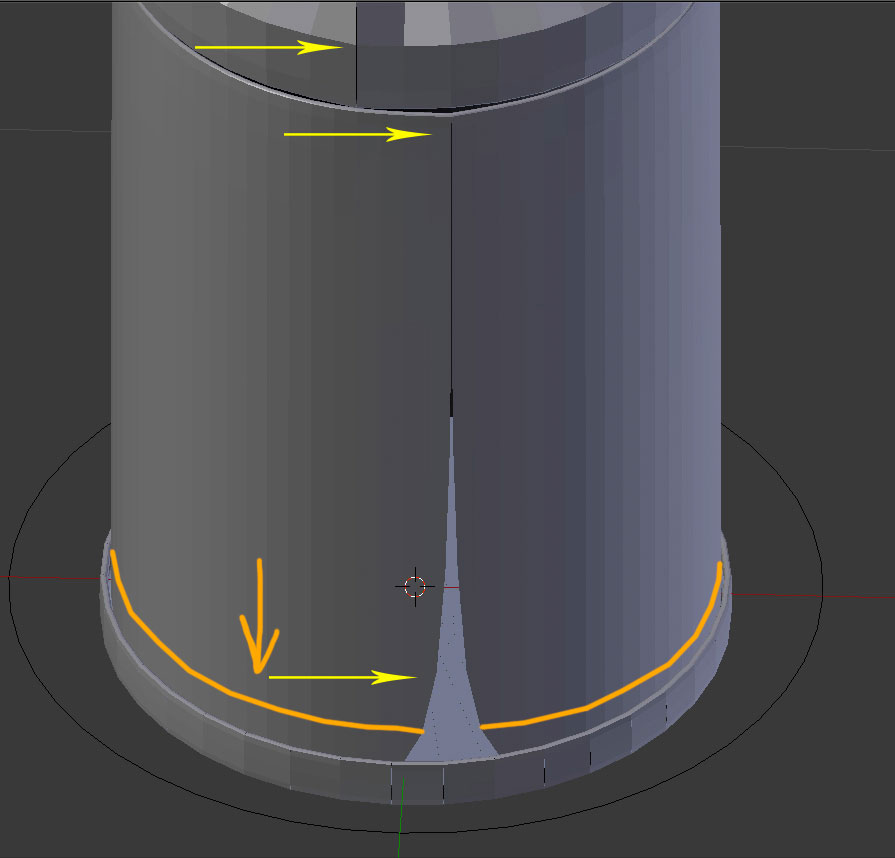
And here's how I would go about generating a cross-hair-based circular mesh (as opposed to a triangle fan circular mesh):
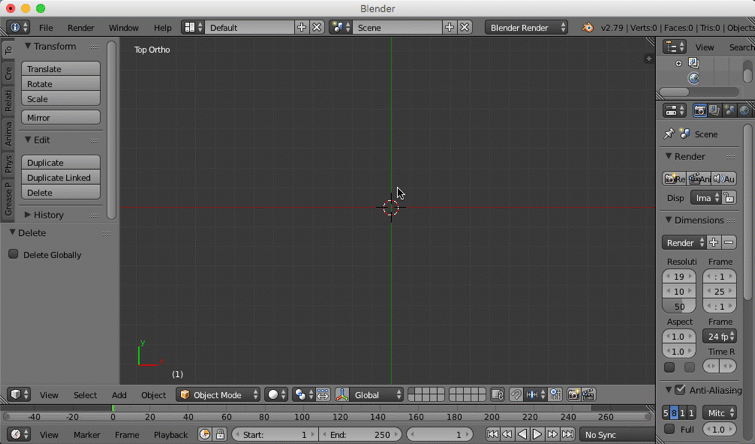
Woah, busting out the grimy textures! Nice job ![]() mathias67. The shape is defined well and the topology is even and minimal. Solid model: Grade A+ stuff.
mathias67. The shape is defined well and the topology is even and minimal. Solid model: Grade A+ stuff.
This is a piece of ART.